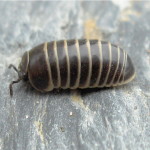Pillbugs and sowbugs, aka “roly-poly”s, “woodlice,” or “potato bugs” are crustaceans, related to shrimp, lobsters, and crayfish. However, they’re rarely in the same place, except at the occasional family reunion.

The Difference Between Pillbugs and Sowbugs
Pillbugs and sowbugs are not the same, and are often confused. Pillbugs can roll up themselves in a ball with their legs tucked inside when disturbed, whereas the sowbug does not have this ability. Pillbugs also roll up to keep their gills moist and prevent drying out.
Another difference: Pillbugs have oval backs, where as sowbugs have round backs. Pillbugs are smaller than sowbugs, about 9/16 inch long with a grayish body and 14 legs when they reach maturity. Sowbugs also have seven pair of legs, but are grayish-brown, measuring about an inch long.
Biology
Pillbugs and sowbugs can reproduce both sexually (by mating of males and females) and through parthenogenesis (where only the female is involved). After mating, the female produces about two dozen eggs which hatch out in two to nine weeks. The mothers keep their young ones in their pouches where they live for about three to nine days. Each female lays two to three broods each year. The young ones undergo 4 to 5 molts until they reach sexual maturity, maturing in about a year, living for about two years total.
Pest status
Sowbugs and pillbugs are merely nuisance pests. They do not bite or sting, nor have they been found to cause structural damage. Because they need a high amount of moisture to survive, homeowners are best advised to utilize physical control by keeping moisture at a minimum.
Prevention involves sanitation. Cleaning up all rotten or fallen leaves from around the house, yard, and garden removes some of the harborage and breeding sites for pillbugs and sowbugs. Remove standing water.
Prevention also involves exclusion methods. This is best accomplished by caulking/sealing cracks and crevices in and around the house to help prevent pillbug and sowbug entry. Physical control methods involve hand picking, vacuuming, and sweeping up the bugs.
Pest management professionals can also provide chemical control for management of pillbugs and sowbugs. Homeowners should exercise caution applying chemicals, following the pesticide label instructions. Though chemicals can be applied both indoor and outdoor to control sowbugs and pillbugs, only labeled for indoor use should be applied inside the house.
Interesting facts about Pillbugs/sowbugs:
- Pillbugs are crustaceans, not insects. They are related to shrimp and crayfish.
- Mother pillbugs carry their eggs in a pouch.
- Pillbugs are filthy pests; it can drink with its anus and eats its own excrement.
- Like many crustaceans, pillbugs have hemocyanin in their blood, not hemoglobin. Hemocyanin is bluer.
- Sowbugs are the 2nd most diverse group of crustaceans.
- Juvenile pillbugs have a unique molting process where their back molts first. A few days after the back exoskeleton sheds away, the front slides off.
- Pillbugs don’t urinate. They have a high tolerance for ammonia gas.
